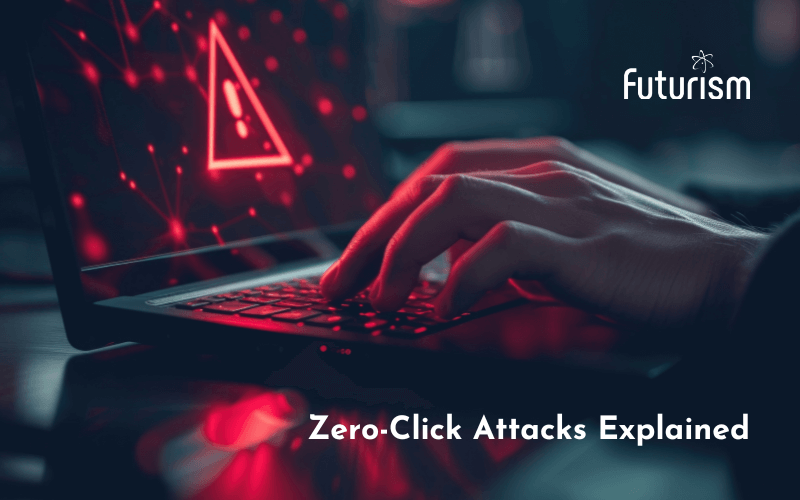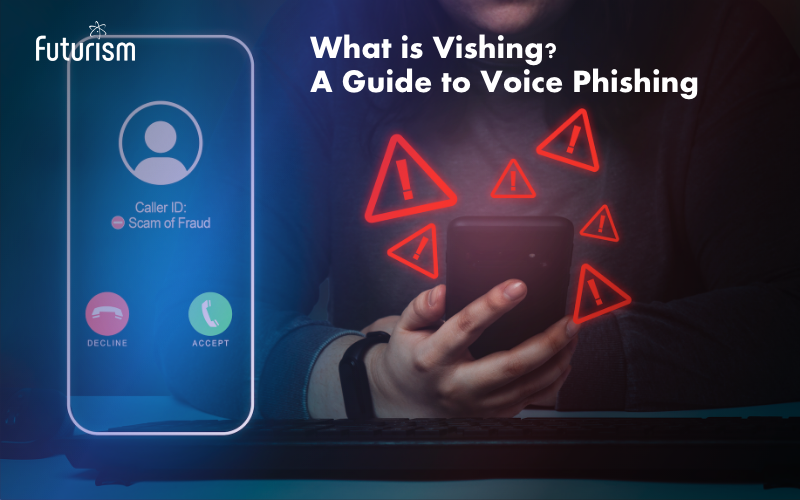Navigating the Shadows: Understanding Zero-Click Attacks in the Digital Age

Futurism Technologies
March 8, 2024 - 1.2K
5 Min Read
From instant communication to endless information, the digital landscape enriches our lives. Yet, this convenience can expose us to unseen dangers. Today, cyber threats are evolving at an alarming pace, demanding constant vigilance and proactive countermeasures. Among these emerging challenges, Zero- Click attacks stand out for their silent operation and devastating potential.
Unlike traditional cyberattacks that rely on user interaction, Zero-Click attacks exploit pre-existing software vulnerabilities, operating entirely in the background. This silent execution makes them particularly insidious, bypassing traditional security measures. This blog throws light on the Zero-Click threat landscape, delving into the technical mechanisms employed by these attacks, analyze their potential impact on individuals and organizations, and most importantly, equip you with effective defense strategies.
Join us as we demystify Zero-Click attacks, equipping you with the knowledge and tools to help you stay one step ahead of the hidden shadows.
Understanding Zero-Click Attacks
Zero-Click attacks exploit vulnerabilities within software applications or operating systems without any user interaction. These sophisticated assaults can silently infiltrate devices, accessing sensitive information or taking control. The absence of user engagement in triggering these attacks makes them particularly insidious and difficult to detect. By leveraging software flaws, attackers can bypass traditional defenses, presenting a significant challenge to digital security mechanisms.
The Mechanics Behind Zero-Click Attacks
The operational foundation of Zero-Click attacks lies in their exploitation of software vulnerabilities. These vulnerabilities can be present in operating systems, messaging platforms, or any application that processes incoming data automatically. When an attacker discovers such a flaw, they can craft a specific payload that, when processed by the target’s system, executes malicious code without any interaction from the victim. This direct exploitation contrasts sharply with phishing and other social engineering attacks, which rely on tricking users into compromising their own security. This is the reason vulnerability assessment and penetration testing (VAPT) is the need of the hour.
Read also: The Rise of Backdoor Attacks!
Types of Zero-Click Attacks
Zero-Click attacks can be categorized based on the vulnerabilities they exploit or their method of delivery. Some of the most common types include:
- Network-Based Attacks: These attacks exploit vulnerabilities in network protocols or services. By sending specially crafted packets to a target’s device, attackers can execute arbitrary code without any user action.
- Messaging App Exploits: Popular messaging platforms have been targets for Zero-Click attacks. Vulnerabilities in these apps can allow attackers to send a message that, once received, compromises the device without the victim ever opening the message.
- System Software Vulnerabilities: Flaws in the operating system or in pre-installed apps can be exploited to gain unauthorized access or control over a device, again without any interaction from the user.
Notable Incidents: Learning from History
The digital industry has witnessed several high-profile Zero-Click attacks, each underscoring the need for robust cybersecurity solutions. While specific details are often kept confidential to prevent exploitation, the lessons from these incidents are clear. The sophistication and stealth of Zero-Click attacks require a proactive and comprehensive approach to digital security which can be achieved by Zero Trust Security Architecture, emphasizing the importance of regular software updates and the development of advanced AI-powered defensive technologies.
Few Notable Examples of Zero-Click Attacks:
- Stuxnet (2010): This complex attack exploited vulnerabilities in industrial control systems, manipulating uranium enrichment centrifuges in Iran. It highlighted the potential for Zero-Click attacks to disrupt critical infrastructure.
- WannaCry (2017): This Ransomware worm leveraged an unpatched vulnerability in Windows, rapidly infecting millions of computers, demanding ransom payments. It demonstrated the widespread damage possible from such attacks.
- SolarWinds Supply Chain Attack (2020): Hackers compromised the SolarWinds Orion platform, inserting malicious code into software updates. This attack affected numerous government agencies and private companies, showcasing the dangers of targeting trusted third-party vendors.
Read also: The Anatomy of a Ransomware Attack – How Does Ransomware Work?
The Impact of Zero-Click Attacks
The consequences of Zero-Click attacks are far-reaching. Individuals may suffer from compromise of personal information, financial loss, and severe privacy violations. For organizations, the stakes are even higher, encompassing not only the immediate data breach but also long-term reputational damage. On a broader scale, these attacks erode trust in digital systems and highlight the perpetual conflict between cybersecurity professionals and threat actors.
Strategies for Prevention and Mitigation
Preventing Zero-Click Attacks necessitates a multifaceted strategy. Regularly updating software ensures that vulnerabilities are patched before they can be exploited. Advanced AI-based SIEM, capable of detecting and neutralizing sophisticated threats, is also crucial. Education plays a pivotal role; by understanding the nature and tactics of these attacks, organizations can adopt safer practices, reducing their vulnerability.
Read also: Beyond Code: Your Ultimate Guide to AI Cybersecurity
The Future of Digital Security: Staying Ahead of the Curve
As technology evolves, so too do the tactics of cybercriminals. The future of digital security is likely to be characterized by the development of AI-driven advanced threat protection solutions, improved encryption methods, and a continued focus on user education. The objective is not merely to respond to emerging threats but to anticipate them, ensuring a secure digital environment for all users.
Takeaways
Zero-Click attacks represent a significant and growing challenge in the field of digital security. Their ability to operate without user interaction makes them particularly dangerous and difficult to defend against. However, by understanding their mechanisms, types, and impacts, and by implementing robust cyber defense strategies, organizations can better protect themselves against these invisible threats. The ongoing evolution of cybersecurity measures, coupled with heightened awareness and education, offers hope in the battle against these and other evolving cyber threats. As we navigate the digital age, Futurism Technologies is dedicated to help businesses strengthen their security posture by offering coming-of-age and AI-driven cybersecurity solutions.
Subscribe Now!
TRENDING POSTS
-
Futurism Returns to Hannover Messe 2024: Leading the Charge in Industrial and Digital Transformation
-
The Role of Smart Maritime IoT Solutions in Enhancing Maritime Safety
-
Data Integration Unlocked: From Silos to Strategy for Competitive Success
-
Navigating the Shadows: Understanding Zero-Click Attacks in the Digital Age
-
AI Reimagined: Crafting Next-Gen AI Apps with Expert Fine-Tuning
-
Explore Next-Gen Digital Solutions with Futurism at MWC 2024
-
Futurism Unleashes the Technology of Tomorrow at MWC Barcelona 2024
-
Futurism AI: Turning Ideas into Apps at Lightning-Fast Speed
-
Accelerate AI Across Your Enterprise With Futurism AI
-
Futurism to Address the Biggest Security Challenges at RSS 2022
-
Futurism at SelectUSA 2022: Steering the Next Wave of Businesses
-
Futurism to Uplift the MSP Business Community at the MSP Expo 2022
-
Futurism Sets Out to Address the Biggest Security Challenges at the RSA Conference 2022
-
5 Ways to Prepare Your Business for Digital Transformation
-
4 Ways To Win at Digital Transformation on a Shoestring Budget
-
Futurism: Empowering MSPs at the Channel Partners Conference & Expo 2022
-
Why AI in Digital Marketing is the Next Big Thing?
-
Futurism brings ‘Mobile First Digital Transformation’ to the fore at MWC Barcelona 2022
-
Cybersecurity for Rural Hospitals: How can Rural Hospitals become Cyber Smart?
-
Futurism Empowers Rural Health Care Community at the AHA Rural Health Care Leadership Conference
-
The Biggest Problem With Cybersecurity In Healthcare Sector, And How IBM QRadar Can Fix It?
-
How IBM MaaS360 is Revolutionizing Endpoint Security in the Healthcare Industry?
-
Futurism to Present its MSP Partner Program at the Channel Partners Conference & Expo 2021
-
EndPoint Security in Healthcare Matters and IBM MaaS360 Can Help
-
How AI Will Enable Faster Adaptation of Digital Transformation
-
How Is Digital Modernization Important In Supplier On-Boarding?
-
Top 10 Email Marketing Tips for This Holiday Season
-
Benefits of using ERP Software for Energy and Gas Industries





